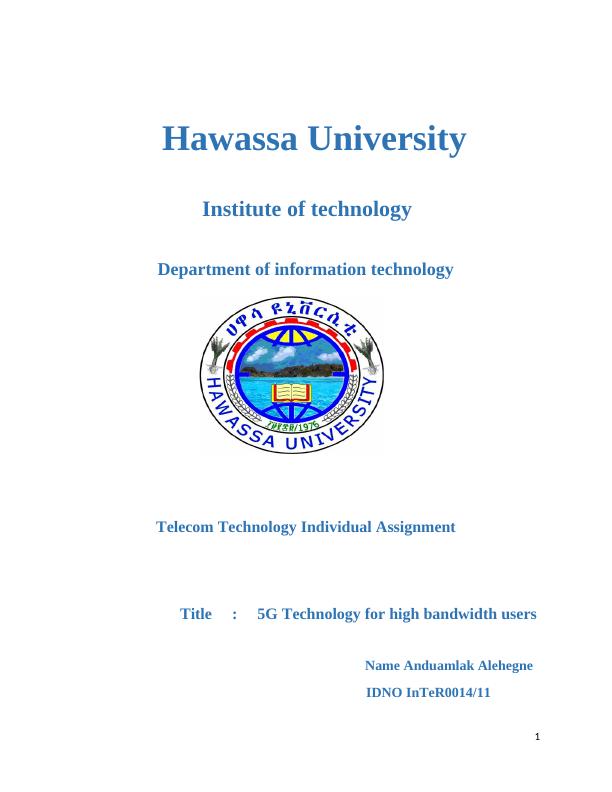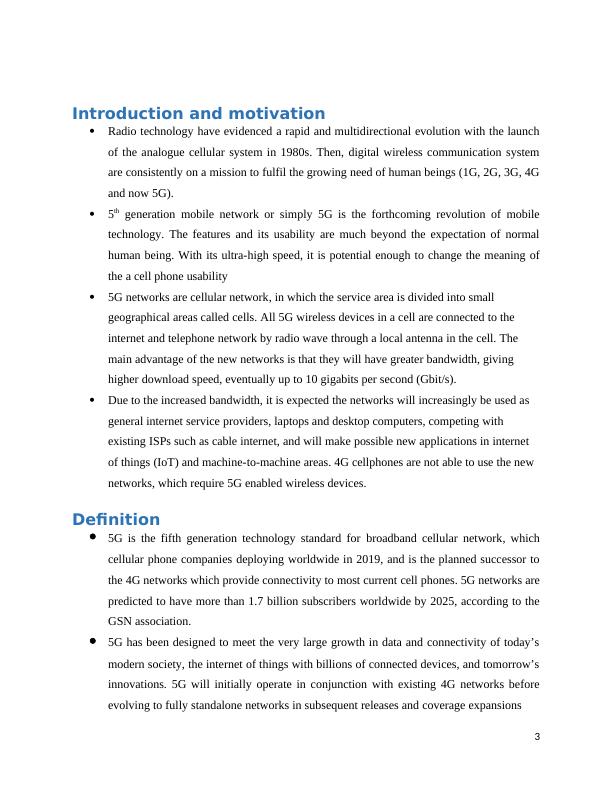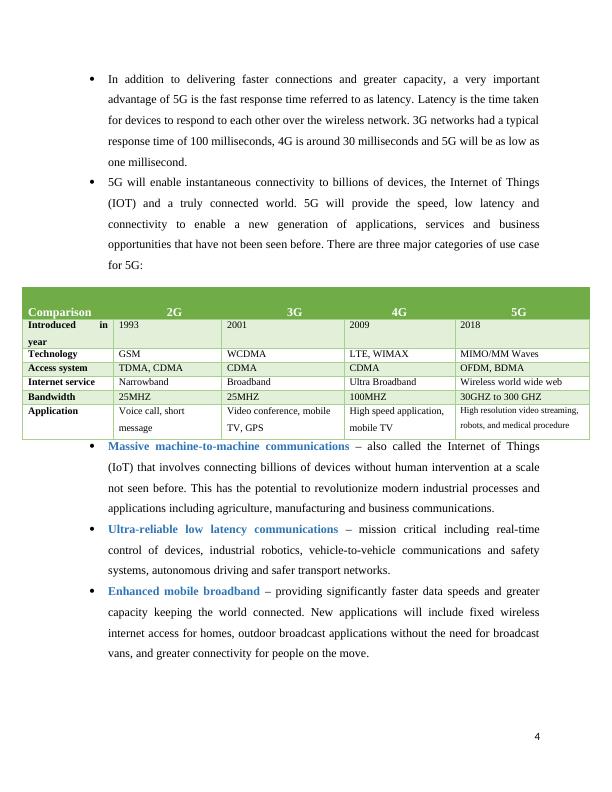Big Data Analytics in 5G - Doc
12 Pages3324 Words70 Views
Added on 2021-08-16
Big Data Analytics in 5G - Doc
Added on 2021-08-16
ShareRelated Documents
Hawassa University
Institute of technology
Department of information technology
Telecom Technology Individual Assignment
Title : 5G Technology for high bandwidth users
Name Anduamlak Alehegne
IDNO InTeR0014/11
1

Table of ContentsIntroduction and motivation......................................................................................................................3
Definition....................................................................................................................................................3
Historical Background.................................................................................................................................5
Application..................................................................................................................................................6
1. High-speed mobile network............................................................................................................6
2. Entertainment and multimedia.......................................................................................................6
3. Internet of Things – Connecting everything.....................................................................................6
4. 5G for the Automotive Domain.......................................................................................................6
5. Big Data Analytics in 5G...................................................................................................................7
6. OSS/BSS Impact with 5G Applications and Services.........................................................................7
7. Power Electronics............................................................................................................................7
Advantage of 5G technology......................................................................................................................7
1. Improved Bandwidth...........................................................................................................................7
2. Tremendous Speeds............................................................................................................................7
3. Less tower obstruction........................................................................................................................8
4. Connect PCs with handsets..................................................................................................................8
5. Technological Advancements..............................................................................................................8
Disadvantage..............................................................................................................................................8
1. In Healthcare...................................................................................................................................8
2. Additional Cost................................................................................................................................9
3. Broadcast Distance..........................................................................................................................9
4. Battery drain and device overheating..............................................................................................9
5. Upload speeds will consume more data..........................................................................................9
6. Coverage issues in Rural Areas......................................................................................................10
Conclusion.................................................................................................................................................10
Reference..................................................................................................................................................10
2
Definition....................................................................................................................................................3
Historical Background.................................................................................................................................5
Application..................................................................................................................................................6
1. High-speed mobile network............................................................................................................6
2. Entertainment and multimedia.......................................................................................................6
3. Internet of Things – Connecting everything.....................................................................................6
4. 5G for the Automotive Domain.......................................................................................................6
5. Big Data Analytics in 5G...................................................................................................................7
6. OSS/BSS Impact with 5G Applications and Services.........................................................................7
7. Power Electronics............................................................................................................................7
Advantage of 5G technology......................................................................................................................7
1. Improved Bandwidth...........................................................................................................................7
2. Tremendous Speeds............................................................................................................................7
3. Less tower obstruction........................................................................................................................8
4. Connect PCs with handsets..................................................................................................................8
5. Technological Advancements..............................................................................................................8
Disadvantage..............................................................................................................................................8
1. In Healthcare...................................................................................................................................8
2. Additional Cost................................................................................................................................9
3. Broadcast Distance..........................................................................................................................9
4. Battery drain and device overheating..............................................................................................9
5. Upload speeds will consume more data..........................................................................................9
6. Coverage issues in Rural Areas......................................................................................................10
Conclusion.................................................................................................................................................10
Reference..................................................................................................................................................10
2

Introduction and motivation
Radio technology have evidenced a rapid and multidirectional evolution with the launch
of the analogue cellular system in 1980s. Then, digital wireless communication system
are consistently on a mission to fulfil the growing need of human beings (1G, 2G, 3G, 4G
and now 5G).
5th generation mobile network or simply 5G is the forthcoming revolution of mobile
technology. The features and its usability are much beyond the expectation of normal
human being. With its ultra-high speed, it is potential enough to change the meaning of
the a cell phone usability
5G networks are cellular network, in which the service area is divided into small
geographical areas called cells. All 5G wireless devices in a cell are connected to the
internet and telephone network by radio wave through a local antenna in the cell. The
main advantage of the new networks is that they will have greater bandwidth, giving
higher download speed, eventually up to 10 gigabits per second (Gbit/s).
Due to the increased bandwidth, it is expected the networks will increasingly be used as
general internet service providers, laptops and desktop computers, competing with
existing ISPs such as cable internet, and will make possible new applications in internet
of things (IoT) and machine-to-machine areas. 4G cellphones are not able to use the new
networks, which require 5G enabled wireless devices.
Definition
5G is the fifth generation technology standard for broadband cellular network, which
cellular phone companies deploying worldwide in 2019, and is the planned successor to
the 4G networks which provide connectivity to most current cell phones. 5G networks are
predicted to have more than 1.7 billion subscribers worldwide by 2025, according to the
GSN association.
5G has been designed to meet the very large growth in data and connectivity of today’s
modern society, the internet of things with billions of connected devices, and tomorrow’s
innovations. 5G will initially operate in conjunction with existing 4G networks before
evolving to fully standalone networks in subsequent releases and coverage expansions
3
Radio technology have evidenced a rapid and multidirectional evolution with the launch
of the analogue cellular system in 1980s. Then, digital wireless communication system
are consistently on a mission to fulfil the growing need of human beings (1G, 2G, 3G, 4G
and now 5G).
5th generation mobile network or simply 5G is the forthcoming revolution of mobile
technology. The features and its usability are much beyond the expectation of normal
human being. With its ultra-high speed, it is potential enough to change the meaning of
the a cell phone usability
5G networks are cellular network, in which the service area is divided into small
geographical areas called cells. All 5G wireless devices in a cell are connected to the
internet and telephone network by radio wave through a local antenna in the cell. The
main advantage of the new networks is that they will have greater bandwidth, giving
higher download speed, eventually up to 10 gigabits per second (Gbit/s).
Due to the increased bandwidth, it is expected the networks will increasingly be used as
general internet service providers, laptops and desktop computers, competing with
existing ISPs such as cable internet, and will make possible new applications in internet
of things (IoT) and machine-to-machine areas. 4G cellphones are not able to use the new
networks, which require 5G enabled wireless devices.
Definition
5G is the fifth generation technology standard for broadband cellular network, which
cellular phone companies deploying worldwide in 2019, and is the planned successor to
the 4G networks which provide connectivity to most current cell phones. 5G networks are
predicted to have more than 1.7 billion subscribers worldwide by 2025, according to the
GSN association.
5G has been designed to meet the very large growth in data and connectivity of today’s
modern society, the internet of things with billions of connected devices, and tomorrow’s
innovations. 5G will initially operate in conjunction with existing 4G networks before
evolving to fully standalone networks in subsequent releases and coverage expansions
3

In addition to delivering faster connections and greater capacity, a very important
advantage of 5G is the fast response time referred to as latency. Latency is the time taken
for devices to respond to each other over the wireless network. 3G networks had a typical
response time of 100 milliseconds, 4G is around 30 milliseconds and 5G will be as low as
one millisecond.
5G will enable instantaneous connectivity to billions of devices, the Internet of Things
(IOT) and a truly connected world. 5G will provide the speed, low latency and
connectivity to enable a new generation of applications, services and business
opportunities that have not been seen before. There are three major categories of use case
for 5G:
Comparison
2G
3G 4G 5G
Introduced in
year
1993 2001 2009 2018
Technology GSM WCDMA LTE, WIMAX MIMO/MM Waves
Access system TDMA, CDMA CDMA CDMA OFDM, BDMA
Internet service Narrowband Broadband Ultra Broadband Wireless world wide web
Bandwidth 25MHZ 25MHZ 100MHZ 30GHZ to 300 GHZ
Application Voice call, short
message
Video conference, mobile
TV, GPS
High speed application,
mobile TV
High resolution video streaming,
robots, and medical procedure
Massive machine-to-machine communications – also called the Internet of Things
(IoT) that involves connecting billions of devices without human intervention at a scale
not seen before. This has the potential to revolutionize modern industrial processes and
applications including agriculture, manufacturing and business communications.
Ultra-reliable low latency communications – mission critical including real-time
control of devices, industrial robotics, vehicle-to-vehicle communications and safety
systems, autonomous driving and safer transport networks.
Enhanced mobile broadband – providing significantly faster data speeds and greater
capacity keeping the world connected. New applications will include fixed wireless
internet access for homes, outdoor broadcast applications without the need for broadcast
vans, and greater connectivity for people on the move.
4
advantage of 5G is the fast response time referred to as latency. Latency is the time taken
for devices to respond to each other over the wireless network. 3G networks had a typical
response time of 100 milliseconds, 4G is around 30 milliseconds and 5G will be as low as
one millisecond.
5G will enable instantaneous connectivity to billions of devices, the Internet of Things
(IOT) and a truly connected world. 5G will provide the speed, low latency and
connectivity to enable a new generation of applications, services and business
opportunities that have not been seen before. There are three major categories of use case
for 5G:
Comparison
2G
3G 4G 5G
Introduced in
year
1993 2001 2009 2018
Technology GSM WCDMA LTE, WIMAX MIMO/MM Waves
Access system TDMA, CDMA CDMA CDMA OFDM, BDMA
Internet service Narrowband Broadband Ultra Broadband Wireless world wide web
Bandwidth 25MHZ 25MHZ 100MHZ 30GHZ to 300 GHZ
Application Voice call, short
message
Video conference, mobile
TV, GPS
High speed application,
mobile TV
High resolution video streaming,
robots, and medical procedure
Massive machine-to-machine communications – also called the Internet of Things
(IoT) that involves connecting billions of devices without human intervention at a scale
not seen before. This has the potential to revolutionize modern industrial processes and
applications including agriculture, manufacturing and business communications.
Ultra-reliable low latency communications – mission critical including real-time
control of devices, industrial robotics, vehicle-to-vehicle communications and safety
systems, autonomous driving and safer transport networks.
Enhanced mobile broadband – providing significantly faster data speeds and greater
capacity keeping the world connected. New applications will include fixed wireless
internet access for homes, outdoor broadcast applications without the need for broadcast
vans, and greater connectivity for people on the move.
4

End of preview
Want to access all the pages? Upload your documents or become a member.
Related Documents
ASSIGNMENT OF WIRELESS NETWORKlg...
|17
|3471
|25
WIRELESS NETWORK AND SECURITY DISCUSSION 2022lg...
|12
|2964
|26
Wireless Network and Securitylg...
|11
|2797
|1
5G Mobile Network and Healthlg...
|7
|2026
|34
Wireless Networks and Securitylg...
|11
|2619
|37
5G New Radio in Wireless Communicationlg...
|12
|3714
|455
